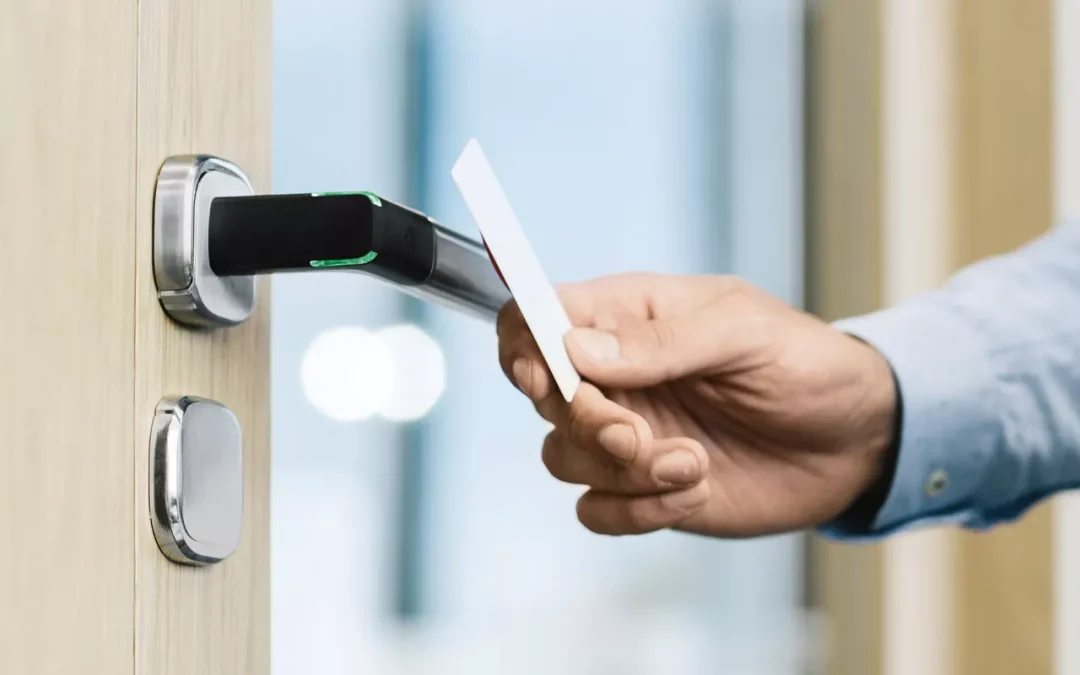Choosing the Right Access Control System: PULSE vs CLIQ vs SMARTair

For friendly & knowledgable service contact us on:
0330 100 5313 hello@williamchannon.co.uk

When it comes to securing commercial premises, choosing the right access control system is critical. At William Channon, we’re proud to be an authorised distributor of three leading ASSA ABLOY solutions: PULSE, CLIQ, and SMARTair. Each offers unique benefits tailored to different operational needs.
Whether you’re managing a multi-site estate, upgrading legacy systems, or planning a new installation, understanding the strengths (and trade-offs) of each system can help you make an informed decision.
What Is Access Control?
Access control manages who can enter, where, and when. It’s the foundation of modern physical security, giving organisations flexible, traceable control over their buildings.
A good system should:
- Prevent unauthorised entry using secure credentials such as keys, cards, fobs, or mobile IDs.
- Record activity so you can see who accessed which areas and when.
- Allow quick updates, so access can be granted or removed instantly.
- Integrate with other systems like CCTV, alarms, or HR software.
Feature Comparison at a Glance
Each ASSA ABLOY system takes a different approach to access control.
Some prioritise sustainability, others focus on audit capability or flexibility.
Here’s how PULSE, CLIQ, and SMARTair compare across their key features:
An In Depth Look At Each Solution
ASSA ABLOY PULSE
PULSE is a self-powered digital locking system that combines electronic and mechanical security in locks/cylinders/padlocks, without batteries or wiring. The system harvests kinetic energy from the key being inserted and turned, to power the electronics in the lock. Access and rights are managed via cloud software (Incedo Business) enabling remote updates of keys.
Key advantages:
- Zero power supply needed for the door lock (no mains wiring, no battery in the lock).
- More sustainable and cost-efficient over the lifecycle (less maintenance), a positive for organisations with sustainability goals.
- Easy retrofit into existing doors, minimal disruption.
- Cloud-based admin means you can revoke a lost key, update permissions remotely.
Trade-offs:
- Still key-based rather than mobile/credential only; for buildings where smartphones or cards are preferred this may be limiting.
- While audit is supported, its depth and real-time nature may not fully match wireless systems.
- If a site needs full real-time wireless update of locks (rather than key insert updates) then other systems may give more.
Who is it suited to?
- High-traffic commercial sites where mechanical ease and low maintenance matter (e.g., multi-residential, offices, shared-space buildings).
- Organisations wanting to upgrade from mechanical locks without major rewiring or power modifications.
- Facilities with sustainability goals and looking to reduce battery-waste and wiring overhead.
ASSA ABLOY CLIQ
CLIQ is a hybrid mechatronic locking system combining mechanical key/cylinder security (via ABLOY PROTEC² or similar) with programmable electronic keys and cylinders. Keys carry a battery and electronic identification; cylinders remain passive, so door-side wiring is not required. The system allows full audit trails, configurable key permissions (time windows, groups), and flexible system management (local, web or mobile).
Key advantages:
- Very high level of mechanical + electronic security: mechanical key shaft + electronic head means dual control.
- No wiring at the lock side — easier retrofit into mechanical installations.
- Sizeable audit/tracking capability (locks and keys log events).
- Suitable for sensitive infrastructure where key control, authentication, audit trails matter.
Trade-offs:
- Keys require battery maintenance (the battery is in the key).
- Mobile credentials (smartphone) are not a core part of the system in all variants (though some newer “Connect” versions add mobile support), check version.
- Because of the dual-tech (mechanical + electronic), the cost may be higher than simpler systems.
Who is it suited to?
- Organisations with higher security demands (e.g., utilities, critical buildings, large estates) needing audit trails, key time windows, revocation.
- Installations where mechanical keying is already entrenched and electronic upgrade is desired without full overhaul.
- Sites where wires to doors are problematic but electronic management is desired.
ASSA ABLOY SMARTair
SMARTair is a wireless access control system with battery-powered locks (escutcheons, cylinders, wall readers, padlocks) and software management that supports multiple levels of credentialing including mobile phones. It offers anything from simple standalone wireless locks for a few doors, to full online wireless systems with smartphone credentials and real-time updates.
Key advantages:
- Real-time (or near real-time) management of user access, credential revocation, live audit trails.
- Supports mobile credentials via smartphone apps (e.g., Openow) as well as cards, fobs.
- Highly scalable: from small sites (Standalone) to large sites (Wireless Online).
- Wireless installation reduces cabling cost and complexity, making it suitable for retrofit or expansion.
Trade-offs:
- Locks have batteries (so requires maintenance) because the lock itself is active.
- For very simple sites (few users/doors, minimal change) the full wireless/real-time capability may be more than needed — potentially higher cost.
- Requires careful planning around online connectivity, credentials lifecycle and cybersecurity (as mobile/online credentials add complexity).
Who is it suited to?
- Modern office environments, campuses, multi-tenant buildings where users change roles frequently, mobile credentials are a requirement, and scalability is key.
- Organisations wanting to move into mobile key ecosystems, integrate with other building systems (e.g., elevators, turnstiles).
- Sites where fast credential revocation and audit is important (for example coworking spaces, flexible workspaces).
How William Channon Can Help
As an authorised distributor for all three of these ASSA ABLOY product ranges, William Channon offers:
- Expert advice to help you choose which solution aligns with your building type, user-profile, budget and maintenance capability.
- Supply and installation services — from retrofit into existing mechanical systems through to full wireless digital access control.
- Training and ongoing support for facility, estates and security managers.
- Site surveys and audits to assess your specific needs, compliance implications (e.g., data protection, audit logs), and long-term maintenance model.
Final Thoughts
Access control is not just about “locking doors”. As we’ve seen with PULSE, CLIQ and SMARTair, your locking and access control system is now a data system, capturing user events, audit trails, permission changes, and potentially mobile credentialing. Selecting the right system means balancing security, usability, maintenance and cost.
If you’d like to discuss which system works best for your building, user-profile or future-proofing requirements, we’re ready to help. Get in touch with our team at William Channon to book a consultation or site survey.
People we typically help


Security Managers
Keeping your building and colleagues safe is crucial. If you experience a break in, loss of keys or just need advice on an existing system having a locksmith and access control specialist at hand, who are ready to react quickly and efficiently is essential.

Estate or Facilities Managers
Whether you are in charge of a single or multiple sites, security will be one of the main things you are responsible for to keep your buildings running smoothly. We can offer peace of mind that you are fully supported ongoing for anything security related.

Maintenance Managers
Your day to day building maintenance duties will be quite varied but we understand that maintaining safety as well as building access will no doubt be towards the top of that list. We have supported maintenance managers for decades so rest assured we have you covered.

Homeowners
Whether you are locked out of your home, or simply need to feel more safe and secure we can offer advice on the best products available as well as offer full installation.
None of the above sound like you? No problem, whilst these are the people we most commonly help we've worked on projects for all sorts of professionals so contact us below to talk to us about your requirements.
How can we help?
Fill out the form below, or if you would prefer you can call us on 0330 100 5313
or email us at hello@williamchannon.co.uk
Some of our trusted suppliers





TESTIMONIALS
What Our Customers Say
